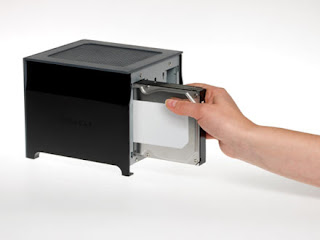Some time ago I
upgraded my little Netgear Stora with new hard drives and although a
little bit fiddly to get up and running it went smoothly, but I was
left with a couple of 1TB hard drives just kicking around that I
wanted to do something with. It seemed sensible to use these for
additional offline storage to back up the data I had on my NAS, so if
anything happened to it I always had an offline spare. I tried loads
of different linux based solutions from FreeNAS, to ubuntu and
although I found some systems that I quite liked, I preferred the
idea of having a low power dedicated NAS unit, similar to the Stora,
rather than committing a whole PC to the task.
I checked out a few
chassis-only options and although I would have preferred another
Stora it was quite pricey compared to the ShareCenter, so I went for
that one! …..and oh boy, what a mistake that was. It's not often
that I get a genuinely bad piece of kit, but unfortunately in this
case I did and I'm going to explain why D-Link seriously messed this
unit up.
For the uninitiated,
the Share Center is one of DLinks Network Attached Storage offerings
aimed squarely at the home market. It boasts 2 SATA hard drive slots
which enable hot swapping of hard drives with no data loss if in RAID
1 configuration and a maximum storage capacity of 4TB in a RAID 0
configuration.
Styling, hardware and
concept are all top-notch, so what is wrong with this unit? Well,
the software. It is so ridiculously unintuitive to navigate that I
must have spent an hour just figuring out the menu structure and what
the options were. There is an utterly pointless set of additional
'apps' that offer no useful functionality whatsoever. I have no idea
what D-Link were thinking when they attempting to develop software
for what is a nice set of integrated hardware but they seriously
messed up and not in the easy to forgive way, there was clearly no
attempt to assess the usability of this product after the software
was included. I am really really tempted to draw out the
organisational structure they should have used to develop this
product and map out the integration and testing process but that
should be teaching them to suck eggs.
I've spent many hours
with this little box, and I still can't get user accounts to work
properly, or for one of my windows computers to even be able to log
on to it; there is a bug in the software where if you have a user
account on your pc with the same name as the unit it will fail to log
on – and there is no fix for this. The only usable functionality I
have been able to get out of this unit is for some of my computers to
be able to use it when there are no security settings in place, which
is of no use in most networking environments.
At the end of the day
it looks to me like software modules from different providers were
bolted together in an attempt to provide 'NAS' functionality but the
look, feel, and functionality of the software renders this unit
completely useless. I am genuinely disappointed with this unit and
D-Link should be ashamed of themselves for releasing untested rubbish
to the market. Take my advice, if you are looking for a simple home
NAS solution then spend a few more pounds on something better and from
a company who actually understands how to deliver software and
hardware in a single package, QNAP or Netgear are great examples.






